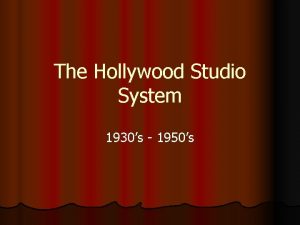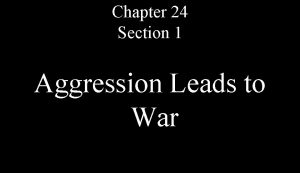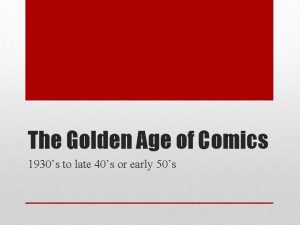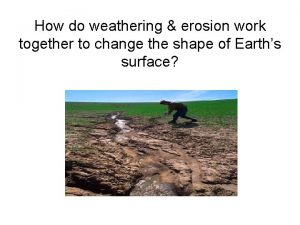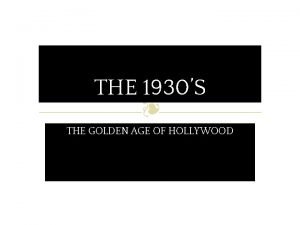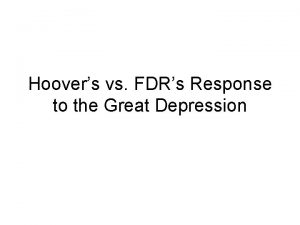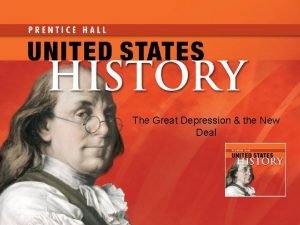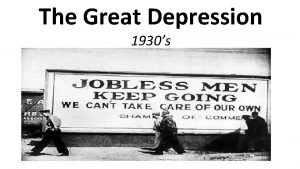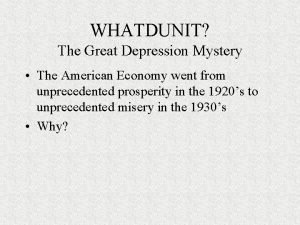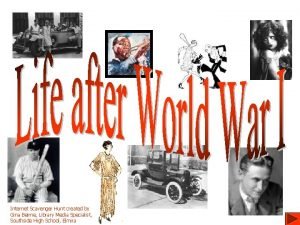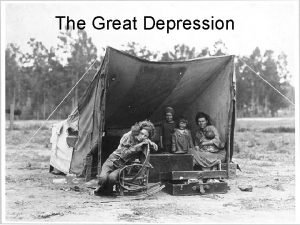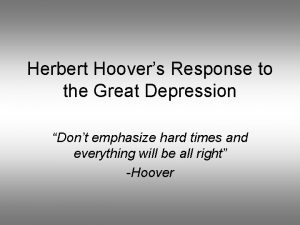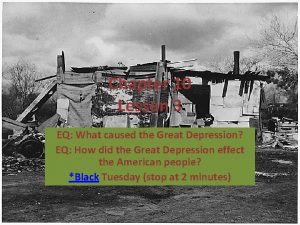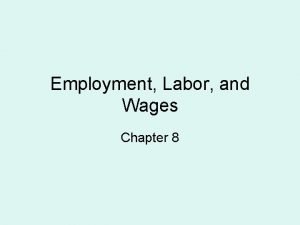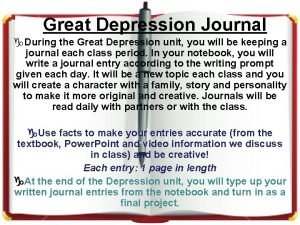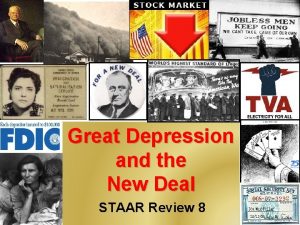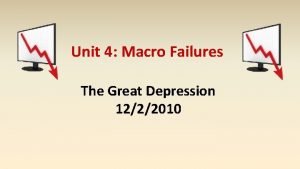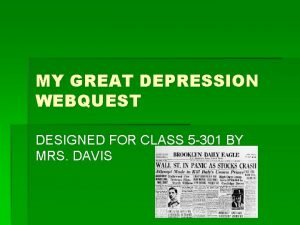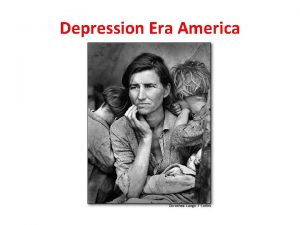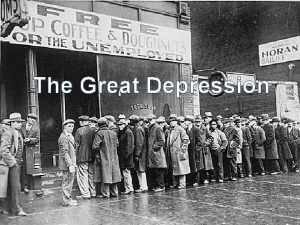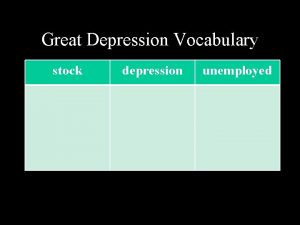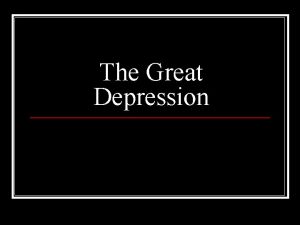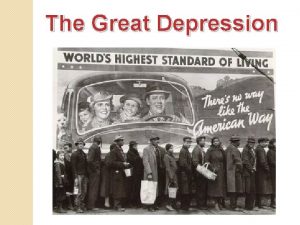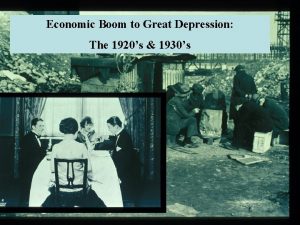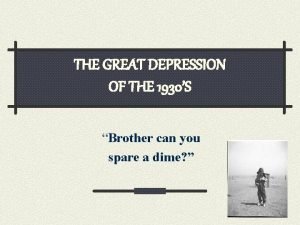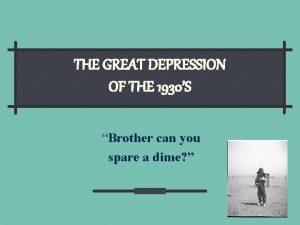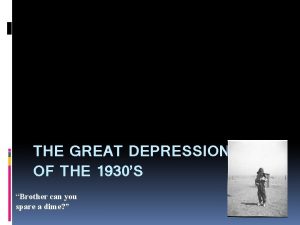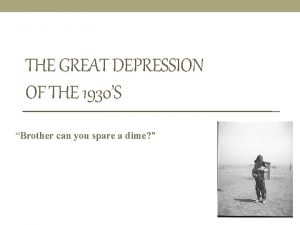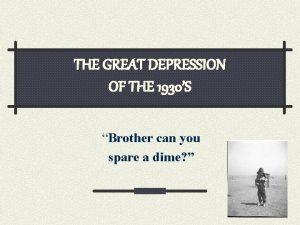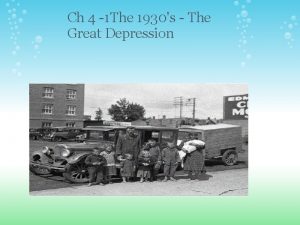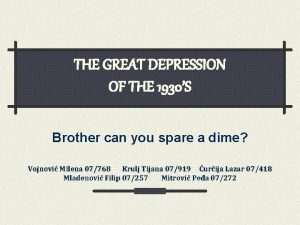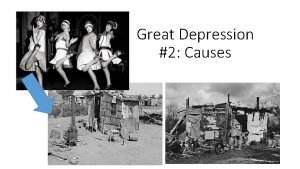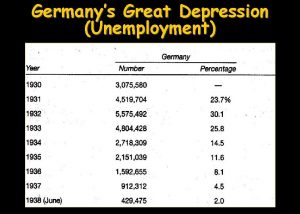THE GREAT DEPRESSION America in the 1930s 7
































- Slides: 32

THE GREAT DEPRESSION America in the 1930’s 7 th Period’s Perspective

How did it start? � � The Crash of 1929 2/19 Starter: � What was the main cause of the Crash of 1929 and what did it start within American society?

Herbert Hoover � � � � Born in Iowa in 1874 and grew up in Oregon Son of a Quaker blacksmith He had a reputation as a public servant as an engineer, administrator and humanitarian Went to Stanford University Married his Stanford sweetheart Lou Henry Lived in China until the Boxer Rebellion in 1900 Lived in London at the time Germany declared war on Britain in 1914

As President � � “Rugged Individualism” “One of the great problems of government is to determine to what extent the Government itself shall interfere with commerce and industry and how much it shall leave to individual exertion… By adherence to the principles of… opportunity and freedom to the individual, our American experiment has yielded a degree of well-being unparalleled in all the world”

Nation’s Response to Hoover � � � He loses favor and people lose faith in his ability to help Bonus March The voters react in both the 1930 midterm election and 1932 presidential election.

Franklin Delano Roosevelt � � � Born is Hyde Park, New York in 1882 Attended Harvard and Columbia University Married his second cousin Eleanor in 1905 Summer of 1921 he comes down with polio, a disease that destroys the nerves and is considered a childhood disease. He is determined to walk again and works hard to exercise is legs through swim and water exercising.

Franklin Delano Roosevelt � � He made appearance on crutches at the 1924 Democratic Convention, after that he was always seen holding on to someone’s arm or using a cane to balance himself. He never wanted to people to think that he was incapable of accomplishing anything due to his “handicap”

Franklin Delano Roosevelt: Accomplishments as President � New Deal Executed programs designed to provide the unemployed with government jobs � Agencies such as the AAA, CCC, REA, WPA, TVA, SEC, FDIC, NRA, and FSA � � Repealed Prohibition � � � Helped him win the next election Eventually the gross national product went up to 34% Unemployment went from 25% to 14% Established the Good Neighbor Policy with Latin America in place of the Monroe Doctrine Was elected for a third and fourth terms. Served as president from 1933 -1945 � Felt he was the most fit to lead the country during the war

Pros and Cons Pros Cons 1. Lead America through 1. Critics say he the worst economic centralized power crisis yet. around himself 1. Controlled government 2. Helped Great Britain, and democratic party Chinese Nationalists 2. Court packing incident of and the Soviet Union 1937 fight the Axis Powers 3. Ran for more than the 3. Ronald Reagan often traditional 2 terms. mentioned and quoted 2. People disagree with FDR government planning of the economy 3. Got America involved in War

How did government change? � � Went from hands off to more hands on Become aware of and tried to help those American citizens who were suffering Also grew in size with the new agencies. Helped more with public works and improvements.

What happened to the people? � People lost: � Their jobs � Their life savings � Their homes � Their dignity

Economic Problems � � Crash of 1929 Bank Failures of the 1930 s Crop failures and drought Business lay off up to 25% of the American workforce

Music of the Day � � � The Music industry was affected by the depression Sales declined from 100 million in the 1920’s to just 10 million dollars in sales However the development and popularity of the radio also cause an expansion of American exposure to music, as the radio was one of the only consumer products that people would work to keep.

Genres � � � There was a wide variety of music available at the time. Anything from Broadway show tunes, Jazz, Blues, Swing, Protest, Folk and Classical. The key to the music was two fold: � First bring the problems of the American people to the public conscience. � Second, to give the millions of Americans without hope, the hope that things would get better.

Songs � � � There were a variety of songs but we are going to look at a Protest Song by Billie Holliday “Strange Fruit” https: //www. youtube. com/watch? v=h 4 Zyu. ULy 9 zs Let’s compare it to a modern popular protest song. “The Hanging Tree” https: //www. youtube. com/watch? v=a. JISG 67 Fje M

Lyrical Comparison � � � What is “Strange Fruit” talking about? What is “The Hanging Tree” talking about? Are similarities in their tone and message? If so what are they? Are there differences? If so what are they? Does the music of the 30’s still influence our music today?

Social Problems � � Segregation is still a big part of American Society at this time. With the economic and political issues of the day, Jim Crow becomes in more enforces and southern lynching become even more prevalent. Listen to Billie Holliday one more time and see if you can see southern society of the 30’s. https: //www. youtube. com/watch? v=98 Cxk. S 0 vz B 8

Social Problems � � These problems were not just in the south. As people fled the dust bowl, many went to California to find work in the industry they knew best, farming. We are going to watch a segment from Ken Burn’s the Dust Bowl about the experiences of Migrate families.

Fashion � � The fashion of the day was very practical and yet glamorous at the same time. Women who could afford to wore dresses that were simple and yet chic. Shoes were focused more on a simple heel with a possible peep toe. Hats were still important and while they may not be a decorative as in the past, the simple was still glamorous with its simple ribbon accents.

Fashion

Beauty � � � Beauty was all about Hollywood glamor and looking like the starlets of the time including: Greta Garbo, Katherine Hepburn and others. They all have their signature look but also had commonalities such as thin eyebrows and long luxurious eyelashes. Hair was curls and either pinned up or bobbed short like the 20 s.

Beauty

Men’s Fashion - - Very slick, simple and clean cut. All respectable men wore hats, mostly fedoras Every man whether a blue collar or white collar worker wore slacks and button down shirt outside of work. Jeans and overalls were worn for more labor intensive work such as farming Shoes were all made of leather whether more of a loafer type or a boot. Men kept their hair cut short and the clean shaven look was more in than the beards of the 19 th century or the mutton chops of the early 20 th.

Men’s Fashion

Sports in the 1930’s � � Baseball Olympics of 1936

Dance � � Many of the social dances of the 1920’s continued but people look to dance competitions as a way to gain fast money. These competition would last anywhere from 24 hours to days at a time and the prize money would go to the last couple standing. These were called dance marathons https: //www. youtube. com/watch? v=5 ya. YQk 9 n. Is

Film � The film industry tried to bring hope and an escape to the people who could afford the price of a ticket with films like: � The Wizard of Oz � Gone with the Wind � Shirley Temple Films � https: //www. youtube. com/watch? v=fbt. R 1 DNg. Nak

Photography � FSA- Farm Security Administration � One of the new deal programs that hired famous phtographers to document the Great Depression through photography � The goal was to show the public and Congress the full extend of the problems that FSA was trying to solve � Built a collection of more the 80, 000 photographs of the Great Depression � One of these photographers was Dorothea Lange.

Dorothea Lange � � Her photographs of the Great Depression made her one of the most famous photographers of the 20 th Century. Focused on the unemployed, migrant workers and homeless Has influenced documentary and journalistic photography of today. http: //www. livinghistoryfarm. org/farminginthe 30 s/water_14. html

Literature

How did it end?

How do we view the Great Depression today?
 Computers 1930s
Computers 1930s Entertainment in the 1930s
Entertainment in the 1930s The hollywood studio system in the 1930s and 1940s
The hollywood studio system in the 1930s and 1940s Joseph stalin political movement and beliefs
Joseph stalin political movement and beliefs Comics in the 1930s
Comics in the 1930s Dust bowl 1930s
Dust bowl 1930s Golden age of hollywood 1930s
Golden age of hollywood 1930s The great depression outline
The great depression outline Great depression causes
Great depression causes Summary of great depression
Summary of great depression What is the main idea of the cartoon?
What is the main idea of the cartoon? Great depression
Great depression 1932 electoral map
1932 electoral map The ingenious quarterback
The ingenious quarterback Poverty during the great depression
Poverty during the great depression During the great depression there were many wanderers
During the great depression there were many wanderers Overspeculation great depression
Overspeculation great depression Five effects of the great depression
Five effects of the great depression Great depression
Great depression Great depression ap world history definition
Great depression ap world history definition Hoover's response to the great depression
Hoover's response to the great depression Pros and cons of the great depression
Pros and cons of the great depression Great depression acrostic poem
Great depression acrostic poem Chapter 8 employment labor and wages
Chapter 8 employment labor and wages How did the great depression impact the world
How did the great depression impact the world Stock market crash cartoon 1929
Stock market crash cartoon 1929 Great depression journal entry
Great depression journal entry Mexican repatriation apush
Mexican repatriation apush Great depression vocabulary jeopardy
Great depression vocabulary jeopardy High tariffs great depression
High tariffs great depression Cpi during the great depression
Cpi during the great depression Great depression
Great depression Great depression webquest
Great depression webquest


